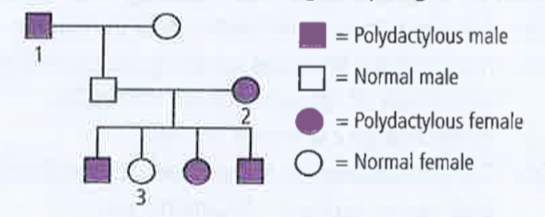A disease which often produces deformities of fingers and toes is
Poliomyelitis
Tuberculosis
Typhoid
Leprosy
The correct Answer is:D
Step by step video, text & image solution for A disease which often produces deformities of fingers and toes is by Biology experts to help you in doubts & scoring excellent marks in Class 12 exams.
Updated on:21/07/2023Topper's Solved these Questions
- HUMAN HEALTH AND DISEASEBook:CENGAGE BIOLOGYChapter:HUMAN HEALTH AND DISEASEExercise:ARCHIVES
Explore 45 Videos
- EVOLUTIONBook:CENGAGE BIOLOGYChapter:EVOLUTIONExercise:Archives
Explore 38 Videos
- HUMAN REPRODUCTION Book:CENGAGE BIOLOGYChapter:HUMAN REPRODUCTION Exercise:Assertion -Reasoning Question
Explore 12 Videos
Similar Questions
A truth which is often repeated.
View SolutionIn humans, polydactyly (i.e. presence of extra fingers and toes) is determined by a dominant autosomal allele (P) and the normal condition is determined by a recessive allele(p). Find out the possible genotypes of family members 1,2 and 3 in the given pedigree.

View Solution
Knowledge Check
The force which responds to produced deformation is a body is
Adeforming forceBforceCrestoring forceDintermolecular forceThe forces which produces deformation in a body is called
Adeforming force.Belectrostatic force.Crestoring force.Dintermolecular force.Rh factor can produce disease
AAIDSBTurner's syndromeCerythroblastosis foetailsDsickle-cell anaemia
Name the disease of cattle in which they produce excessive saliva.
View SolutionThis pedigree is of a rare trait, in which children have extra fingers and toes. Which one of the following patterns of inheritance is consistent with the pedigree?
View SolutionIn humans polydactyly (i.e., presence of extra fingers and toes) is determined by a dominant autosomal allele (P) and the normal condition is determined by a recessive allele (p). Find out the possible genotypes of family members 1,2 and 3 in the given pedigree

View SolutionThis pedigree is of a rare trait, in which children have extra fingers and toes. Which one of the following patterns of inheritance is consistent with this pedigree

View SolutionLactic acid is produced quite often in human
View Solution

